On the left bank of the Khabour River, in the center of Al-Hasaka, the archaeological hill, which is considered the largest in the governorate, sits at a distance of 1,700 meters where the Khabour and Jagjeg rivers meet.
Through years of systematic excavation, the national archaeological mission in the Department of Antiquities of Al-Hasaka worked to find out the role the site played during 2000 years BC and the subsequent centuries and to confirm the hypothesis that this hill contains the Assyrian city of Makrizi, which was mentioned in the cuneiform figures discovered in “Durkatlemu,” which is currently known as “Sheikh Hamad” hill in Deir Ezzor.

The archaeological researcher, Dr. Abd al-Masih Baghdou, who worked as director of al-Hasaka archeology department during the successive seasons of excavation at the site between 2008 and 2011, explained that three levels were discovered. The first level dates back to the period of the Arab-Islamic civilization 700-1500 AD, while the second level dates back to the period of Byzantine civilization 400-700 AD, where a cathedral was found there, its architecture dates back to the early Christian period. As for the Assyrian level, a corner of a significant building dating back to the modern Assyrian era was exposed.
According to Baghdou, the archaeological team working at the site found that the cathedral was built of basalt stone and is covered and coated with plaster. It is 31 meters long and 18 meters wide. Some of the discovered parts of its walls are 2.10 meters high.
 The cathedral consists of three sections. The first is the courtyard which is composed of three halls and a floor paved in the form of tiles that represent various geometric shapes. The three halls are separated from each other by bases of columns made of basalt stone with stucco capitals decorated with ornaments and crosses.
The cathedral consists of three sections. The first is the courtyard which is composed of three halls and a floor paved in the form of tiles that represent various geometric shapes. The three halls are separated from each other by bases of columns made of basalt stone with stucco capitals decorated with ornaments and crosses.
The second section of the cathedral, the “Holy of Holies”, consists of a temple placed in the middle, to the south of it is the baptismal room and it contains a well preserved font, the ammunition box, which contains the “bones of martyrs” who were killed during the Roman persecution within a wall pit- to the north of it, is the deacon’s room, in which two pottery jugs, a lamp made of bronze and a stone seal were found.
Baghdou stated that the archaeological team found in the third section of the cathedral two presses for converting grapes into wine, dating back to two different periods, while on the southern side, a hall was found that contained a chair made of basalt plastered stones supposed to be dedicated to the bishop.
 With regard to the “baptism font and the ammunition box,” studies have shown that the font is made of hard limestone and placed on a bench adjacent to the eastern wall of the baptismal room. As for the cover of the “Shrine of the Martyrs” box, it is made of marble stone, as human bones have been found inside. It is likely that oil was placed at the top of the box, as it passes through the bones, then descends by the hole of the box into the baptismal font for the visitors of the cathedral to be blessed.
With regard to the “baptism font and the ammunition box,” studies have shown that the font is made of hard limestone and placed on a bench adjacent to the eastern wall of the baptismal room. As for the cover of the “Shrine of the Martyrs” box, it is made of marble stone, as human bones have been found inside. It is likely that oil was placed at the top of the box, as it passes through the bones, then descends by the hole of the box into the baptismal font for the visitors of the cathedral to be blessed.
According to Baghdou, the cathedral is part of a religious complex that also included a church and a cemetery. It was built in the fourth century AD and continued to be in use until the eleventh century AD.
Amal Farhat

